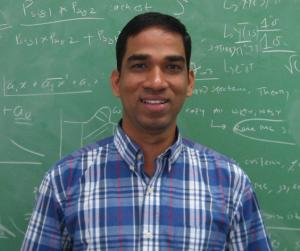Graduate's physics thesis published in Physical Review
University of Hawaiʻi at MānoaContact:
Posted: Sep 15, 2011
Working together with other UH Mānoa colleagues on the Belle experiment at the KEKB factory in Tsukuba, Japan, postdoctoral researcher Himansu Sahoo first reported the first observation of a new type of rare "penguin decay" of the beauty quark and measured its matter-antimatter symmetry violation parameters. Sahoo is a recent Physics and Astronomy Department Phd graduate.
In beauty quark and other radioactive decays observed to date, the interactions responsible for the decay violate mirror symmetry and are left-handed. Sahoo's paper establishes a new method for searching for right-handed currents from physics beyond the Standard Model that will be used in future very high luminosity experiments. The results will be published in the October 2011 issue of Physical Review D Rapid Communications, a leading United States physics journal. Sahoo is the first author of this paper, which was the basis for his Phd dissertation at UH Mānoa.
B Factories are high energy particle accelerators that produce particles containing b (beauty) quarks in large numbers, over 100 million/year. The Belle experiment at KEKB is most celebrated for its critical role in experimentally verifying the theoretical scheme for matter-antimatter asymmetry of Kobayashi and Maskawa, who were awarded the 2008 Nobel Prize in Physics.
B Factories are high energy particle accelerators that produce particles containing b (beauty) quarks in large numbers, over 100 million/year. The Belle experiment at KEKB is most celebrated for its critical role in experimentally verifying the theoretical scheme for matter-antimatter asymmetry of Kobayashi and Maskawa, who were awarded the 2008 Nobel Prize in Physics.
Other UH Mānoa participants in the Belle experiment include faculty members Tom Browder, Mike Peters, Sven Vahsen, Gary Varner, research professor Michael Jones, postdoctoral fellows Igal Jaegle, Kurtis Nishimura, Jared Yamaoka, engineers Matt Andrew and Marc Rosen, graduate students Jamal Rorie and Tom Thorpe and visiting professor Roberto Mussa. The work in the Belle experiment, an international collaboration of physicists from countries in Asia, America, Europe and Australia, is supported by the United States Department of Energy. The University of Hawai‘i group is also constructing the iTOP particle identification detector for the Belle-II experiment for the Super-KEKB factory upgrade that will start operation in fall of 2014 in Tsukuba, Japan.
For more information, visit: http://belle.kek.jp/

